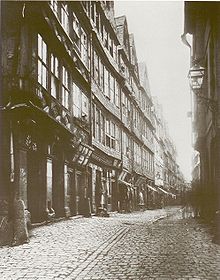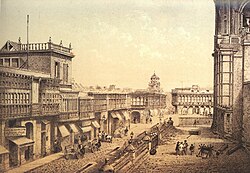
The Old City of Jerusalem is a 0.9-square-kilometre (0.35 sq mi) walled area in East Jerusalem.

A mellah is the place of residence historically assigned to Jewish communities in Morocco.

Giudecca is an island in the Venetian Lagoon, in northern Italy. It is part of the sestiere of Dorsoduro and is a locality of the comune of Venice.
Aljama is a term of Arabic origin used in old official documents in Spain and Portugal to designate the self-governing communities of Moors and Jews living under Christian rule in the Iberian Peninsula. In some present-day Spanish cities, the name is still applied to the quarters where such communities lived, though they are many centuries gone.

Moroccan Jews constitute an ancient community. Before the founding of the State of Israel in 1948, there were about 265,000 Jews in the country, which gave Morocco the largest Jewish community in the Muslim world, but by 2017 only 2,000 or so remained. Jews in Morocco, originally speakers of Berber languages, Judeo-Moroccan Arabic or Judaeo-Spanish, were the first in the country to adopt the French language in the mid-19th century, and unlike among the Muslim population French remains the main language of members of the Jewish community there.

Nicolas Cleynaerts was a Flemish grammarian and traveler. He was born in Diest, in the Duchy of Brabant.

The Muslim Quarter is one of the four sectors of the ancient, walled Old City of Jerusalem. It covers 31 hectares of the northeastern sector of the Old City. The quarter is the largest and most populous of the four quarters and extends from the Lions' Gate in the east, along the northern wall of the Temple Mount in the south, to the Damascus Gate—Western Wall route in the west. The Via Dolorosa starts in this quarter, a path Jesus Christ had to take when he was forced by Roman Soldiers, on his way to his crucifixion. The population of the Muslim Quarter is 22,000.

Fes Jdid or Fes el-Jdid is one of the three parts of Fez, the second largest city of Morocco. It was founded by the Marinids in 1276 as an extension of Fes el Bali and as a royal citadel and capital. It is occupied in large part by the historic Royal Palace, which was once the center of government in Morocco and which is still used on occasion by the King of Morocco today. The district also contains the historic Mellah of the city. Since 1981 it has been classified, along with Fes el-Bali, as a UNESCO World Heritage Site.
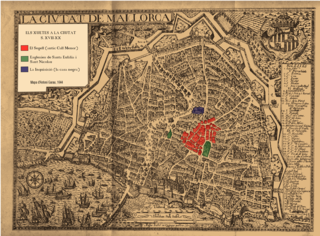
The Xuetes are a social group on the Spanish island of Majorca, in the Mediterranean Sea, who are descendants of Majorcan Jews that either were conversos or were Crypto-Jews, forced to keep their religion hidden. They practiced strict endogamy by marrying only within their own group. Many of their descendants observe a syncretist form of Christian worship known as Xueta Christianity.
This timeline of antisemitism chronicles events in the history of antisemitism, hostile actions or discrimination against Jews as members of a religious and/or ethnic group. It includes events in Jewish history and the history of antisemitic thought, actions which were undertaken in order to counter antisemitism or alleviate its effects, and events that affected the prevalence of antisemitism in later years. The history of antisemitism can be traced from ancient times to the present day.

In the early modern era, European Jews were confined to ghettos and placed under strict regulations as well as restrictions in many European cities. The character of ghettos fluctuated over the centuries. In some cases, they comprised a Jewish quarter, the area of a city traditionally inhabited by Jews. In many instances, ghettos were places of terrible poverty and during periods of population growth, ghettos had narrow streets and small, crowded houses. Residents had their own justice system. Around the ghetto stood walls that, during pogroms, were closed from inside to protect the community, but from the outside during Christmas, Pesach, and Easter Week to prevent the Jews from leaving at those times.

La Giudecca was a term used In Southern Italy and Sicily to identify any urban district where Jewish communities dwelled and had their synagogues and businesses.

Moroccan Jews are Jews who live in or are from Morocco. Moroccan Jews constitute an ancient community dating to Roman times. Jews began immigrating to the region as early as 70 CE. They were later met by a second wave of migrants from the Iberian Peninsula in the period which immediately preceded and followed the issuing of the 1492 Alhambra Decree, when Jews were expelled from Spain, and soon afterward, from Portugal. This second wave of immigrants changed Moroccan Jewry, which largely embraced the Andalusian Sephardic liturgy, to switch to a mostly Sephardic identity.
Jewish Quarter may refer to:
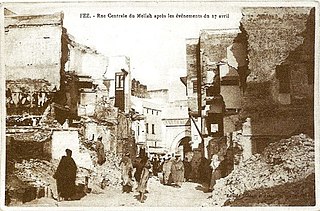
The Fes Riots, also known as the Fes Uprising or Mutiny, the Tritl and the Bloody Days of Fes were riots which started April 17, 1912 in Fes, the then-capital of Morocco, when French officers announced the measures of the Treaty of Fes, which created the French protectorate in Morocco.

The Mellah of Fez is the historic Jewish quarter (Mellah) of Fez, Morocco. It is located in Fes el-Jdid, the part of Fez which contains the Royal Palace, and is believed to date from the mid-15th century. While the district is no longer home to any significant Jewish population, it still contains a number of monuments and landmarks from the Jewish community's historical heritage in the city.
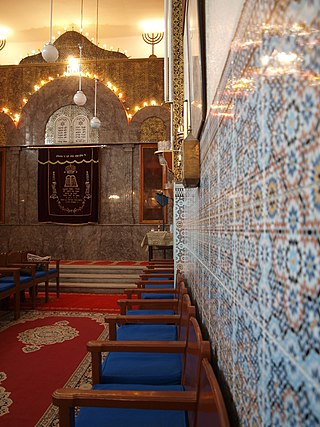
The Slat al-Azama Synagogue or Lazama Synagogue is a Jewish congregation and synagogue, located in Marrakesh, Marrakesh-Safi, Morocco. It is located in the historic Mellah of the old city.

The Mellah of Marrakesh, formerly known as Hay Essalam is the Jewish Quarter (Mellah) of the city of Marrakesh, Morocco. It is the second oldest of its kind in the country.
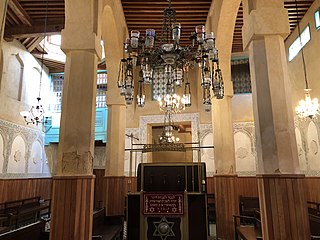
The Al Fassiyine Synagogue or Slat Al Fassiyine is a synagogue located in the Mellah of Fes el-Jdid, within the historic medina of Fez, Morocco. The Slat al-Fassiyine Synagogue was one of the few synagogues where the non-Sephardic rituals of the toshavim continued up until the 20th century.
Judaism in Fez was a community that existed in the city of Fez in Morocco for the last thousand years. Throughout the years, there were rabbis, poets and famous linguists in this community, who greatly influenced the Jewish diaspora in Morocco and the Jewish world.









